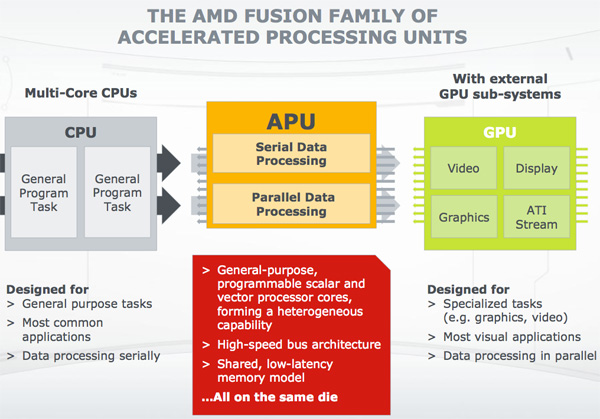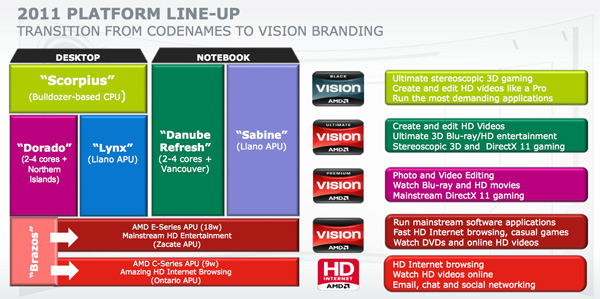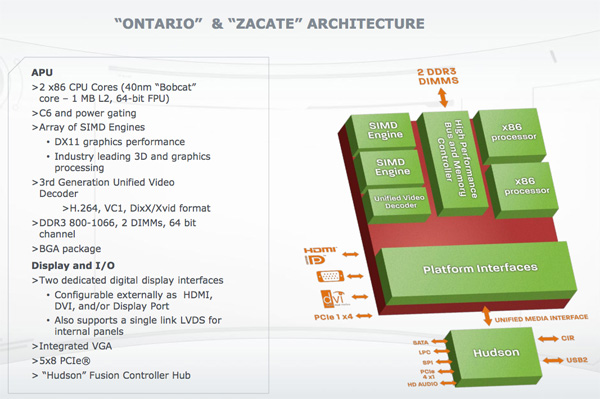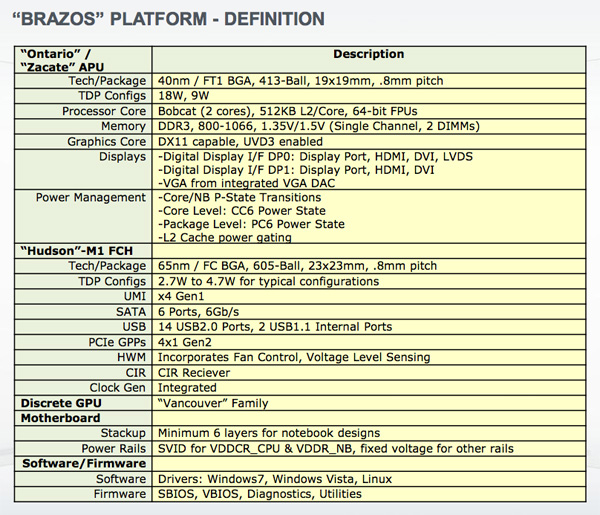Previewing AMD's Brazos, Part 1: More Details on Zacate/Ontario and Fusion
by Anand Lal Shimpi on November 9, 2010 1:09 AM ESTMeet the Brazos
The platform is called Brazos. Brazos encompasses two chips: a Zacate or Ontario APU (Accelerated Processing Unit) and the Hudson Fusion Controller Hub (FCH). This is the whole reason AMD bought ATI, Zacate and Ontario are its first CPU-GPU hybrids.
While AMD is primarily targeting the netbook/ultraportable and notebook markets with Ontario and Zacate (respectively), we’ll also see nettops/desktops and mini-ITX motherboards based on Brazos. This may be the first time we see real competition to NVIDIA’s ION platform.

AMD's Zacate APU, 19mm x 19mm package, 413 balls, 75mm^2 die
Both APUs are built from the same die. Zacate and Ontario are physically identical, they just run at different clock speeds. The 40nm die is manufactured at TSMC and measures 75mm^2. The chip is very cheap to package as well. The BGA package only has 413 balls. As one AMDer put it, these chips are designed to be stamped out as quickly and as cheaply as possible.
Both are available in single and dual core versions, although the single core variant is just a dual-core chip with one core disabled to hit various market segments. Core unlocking is apparently possible, but unexpected given the target for these platforms and the amount of effort OEMs would have to go to in order to enable it.
The CPU cores are based on AMD’s first truly low power client architecture, codenamed Bobcat. We’ve discussed Bobcat in great length already, but at a high level it looks a lot like an out-of-order Atom processor without Hyper Threading. The fundamental architecture advantage should give Bobcat the performance advantage over Atom, at least at identical clock speeds.
The GPU is based on AMD’s 5000 series architecture (Evergreen) and features 80 shader cores and AMD’s new UVD3 decode engine.
The SKUs
At launch you’ll see four SKUs, the combinations and specs are listed below:
| AMD Brazos Lineup | ||||||||
| APU Model | Number of Bobcat Cores | CPU Clock Speed | GPU | Number of GPU Cores | GPU Clock Speed | TDP | ||
| AMD E-350 | 2 | 1.6GHz | Radeon HD 6310 | 80 | 500MHz | 18W | ||
| AMD E-240 | 1 | 1.5GHz | Radeon HD 6310 | 80 | 500MHz | 18W | ||
| AMD C-50 | 2 | 1.0GHz | Radeon HD 6250 | 80 | 280MHz | 9W | ||
| AMD C-30 | 1 | 1.2GHz | Radeon HD 6250 | 80 | 280MHz | 9W | ||
Zacate takes the top two SKUs, while Ontario makes up the bottom two. The difference in TDP is entirely based on the clock speed of the CPU and GPU. And here is my concern. While a pair of Bobcats running at 1.6GHz are just awesome, drop the clock to 1.0GHz and I start getting concerned about performance. AMD didn’t let us test the C-50 but I’m curious to see what the margin of victory will be over Atom at that speed.
The GPU runs at 500MHz at the high end (Radeon HD 6310) and 280MHz at the low end (Radeon HD 6250). This paired with the single channel DDR3-800/1066 memory bus that has to be shared with the Bobcat cores means you should expect sub-5450 levels of performance out of these systems. Given their price point, that’s potentially not too bad. More enticing however is the fact that these APUs gain the benefit of the driver work AMD does on its discrete cards. Finally, game compatibility should be just as good on the low end as it is on the high end - assuming you meet the minimum specs for the title you’re running.
The lack of a brand for the CPU is a bit puzzling, but graphics are where it’s at these days.














106 Comments
View All Comments
Guspaz - Tuesday, November 9, 2010 - link
These are still not really hybrid processors. They've taken a GPU and a CPU (well, two of 'em) and stuck them on the same die. There's no sharing of resources between the two.A true hybrid chip would, in my opinion, share most of the hardware between the CPU and GPU. They'd share execution resources. For example, in these AMD chips, the CPU's SIMD instructions can't take advantage of the GPU's SIMD blocks, from what I'm seeing (forgive me if I'm misreading this all).
Fleeb - Tuesday, November 9, 2010 - link
Have you seen AMD's roadmap for this? It can answer your question.TemplarGR - Tuesday, November 9, 2010 - link
This hardware is amazing, and has many possible uses. The most obvious is in netbooks and ultraportables: It will simply destroy the competition. AMD is right, what this market segment needs right now is more gpu power, not cpu. If their use case involved higher cpu usage, they wouldn't get a netbook or ultraportable anyway.This will also enable great tablets-ipad clones. Ideally a zacate tablet running Linux (for me).
I bought an Acer Aspire One more than 2 years ago, and i am frustrated by Intel policies. The GMA they paired original Atom netbooks with was garbage, consuming 5 times the power Atom consumed... And its performance sucks. Current Atoms still suck, although with more battery power, because Intel hates Atom since it has lower margins. They didn't really expect this kind of success, they didn't want to believe for most people cpu power is enough... They stopped advancing Atom so it is no wonder Netbook sales growth has reached negative numbers... But this tactic will become a boomerang for them...
It is nice seeing AMD making the hardware market exciting again!
Gigantopithecus - Tuesday, November 9, 2010 - link
Can't wait to see whatever numbers AMD lets you give us next week. Hopefully they'll be enough so I can decide whether to wait past the holiday season for Zacate or go with an N550 system now.rayson - Tuesday, November 9, 2010 - link
the total power draw for a netbook based on the brazos platform amd e-series will be 22-24 watts. the cpu performance for a amd e series will be equal to a core i5 520m.i got proof look at the other amd slideshows and videos they have done they have even shown avp running on 720p medium setting bit choppy though
Dark_Archonis - Tuesday, November 9, 2010 - link
CPU performance equal to an i5 520m? Thanks for the laugh. No way that is the case.rayson - Tuesday, November 9, 2010 - link
i am a intel fanboy but amd really will have me buying a netbook nowfic2 - Tuesday, November 9, 2010 - link
In the AMD Brazos Lineup table it lists:AMD E-350 2 1.6GHz
AMD E-240 1 1.5GHz
Seems like the clock speed of the E-350 and the E-240 are reversed unless the dual core does actually have a faster clock than the single.
I don't know why your spam program thinks my comment is spam.
kjanadtech - Tuesday, November 9, 2010 - link
Good article. I currently own a Intel SU4100 system (Gateway ec1430u). I am very interested in zacate platform vs. the intel SU processor platform. There are very few SU4100 + GPU platforms (read MAC Book Air and Zotac IONITX-O-E), so I hope your tests will include these systems as competitors.What is more interesting (to me) is AMD’s Universal Media Interface (UMI) and the Hudson FCH. A necessary upgrade for every ultra portable is a SSD. I hope we will see the SB800 chipset SATA6 performance. Also why isn't there any concern about the memory (CPU, GPU) bottleneck.
Staying tuned for the article next week and I hope to see benchmarks of the sata controller, especially SSD benchmarks, TRIM support, and overall SB800 throughput performance (USB, ethernet, etc).
miahshodan - Tuesday, November 9, 2010 - link
Yeah, I have a gateway 1803 with a su3500 (core 2 solo 1.4) and even with only one core, it is fairly fast, much faster than an Atom with only a 5.5 watt TDP. I am not sure what the TDP of the graphics on the 945 is. The 945 graphics are certainly nothing real impressive, but they will do 720p youtube and accelerated ie9 beta is pretty fast. I see the Su line as the best competitor for the bobcat, and would like to see them compared.